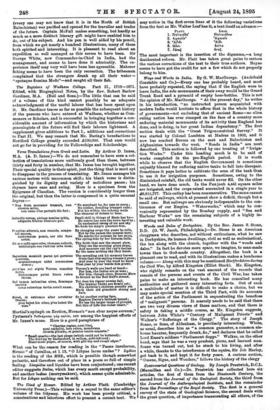Ways and Works in India. By G. W. MaeGeorge. (Archibald
Constable and Co.)—Every one has probably heard, and most have probably repeated, the saying that if the English were to leave India, the sole monuments of their sway would be the Grand Trunk Road and a pyramid of empty beer-bottles. This is not the opinion of Mr. MacGeorge. "At the present day," he writes in his introduction, "no instructed person acquainted with modern India would hesitate to affirm that in the whole history of governments—not excluding that of ancient Rome—no alien ruling nation has ever stamped on the face of a country more enduring material monuments of its activity than England has done, and is doing, in her great Indian dependency." The first section deals with the "Great Trigonometrical Survey." It was started by Colonel Lambton at Madras in 1802, and it now has reached Burma on the east and Baluchistan and Afghanistan towards the west. "Roads in India" are next described. This section is followed by one treating of "Irriga- tion Works." Under this heading much is to be said of works completed in the pre-English period. It is worth while to observe that the English Government is sometimes unjustly blamed for suffering native tanks to fall into disrepair. Sometimes it pays better to cultivate the area of the tank than to use it for irrigation purposes. Sometimes, owing to the diminished rainfall, the old tanks would never fill. On the other hand, we have done much. In the Pun jamb 4,441 square miles are irrigated, and the crops raised amounted in a single year to £8,815,777. This outlay has been remunerative. The same cannot be said of railways, which at present show a deficit, though but a small one. But railways are obviously indispensable to the con- tinuance of our Empire. "Waterworks," which may be con- veniently represented by the Bombay supply, and "Sea and Harbour Works" are the remaining subjects of a highly in- teresting and valuable work.


































 Previous page
Previous page